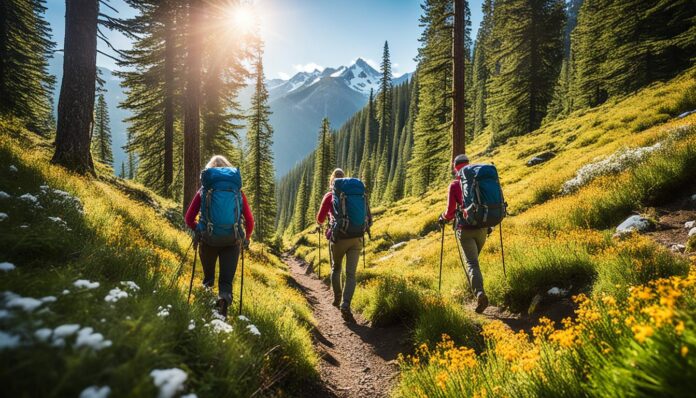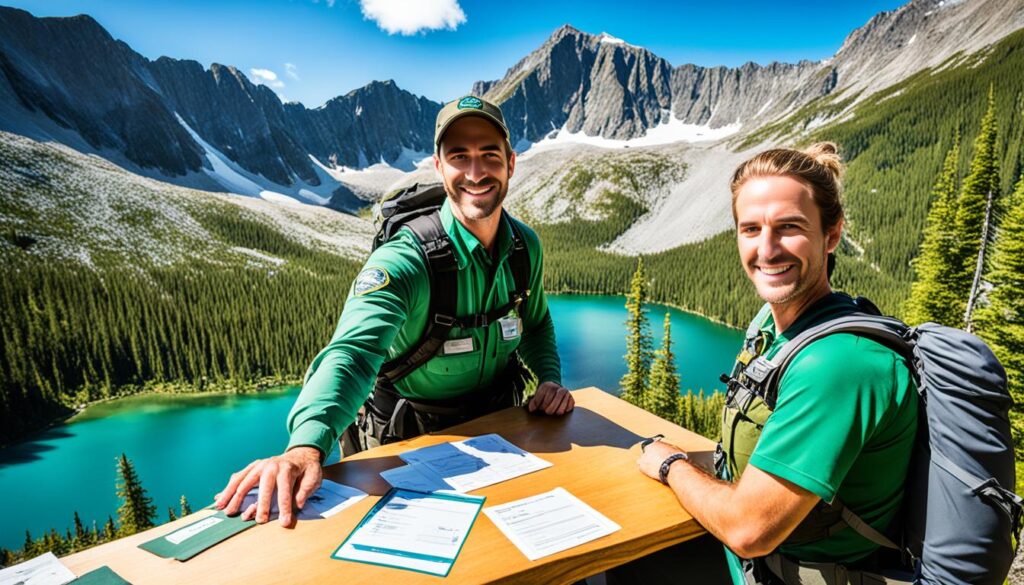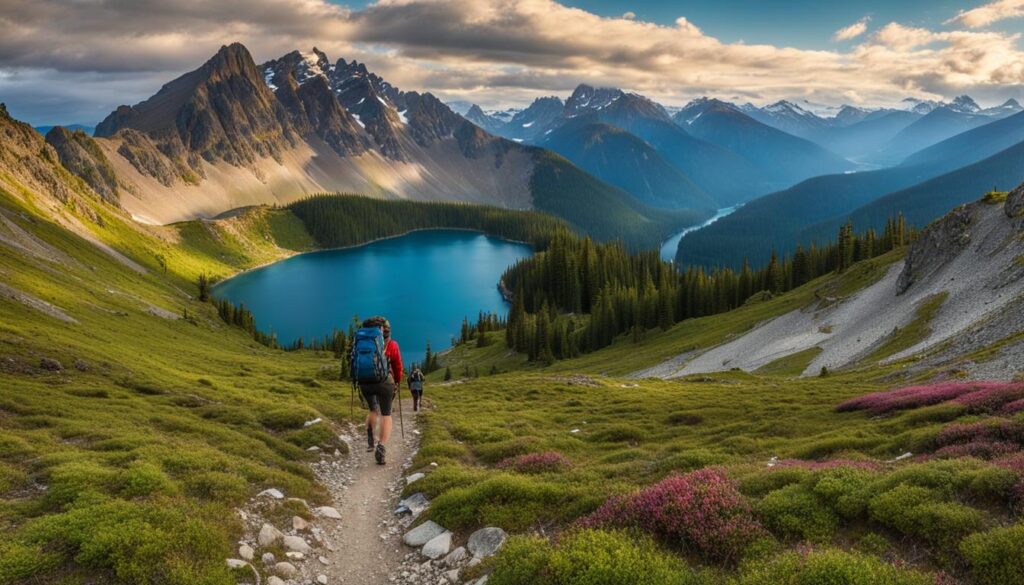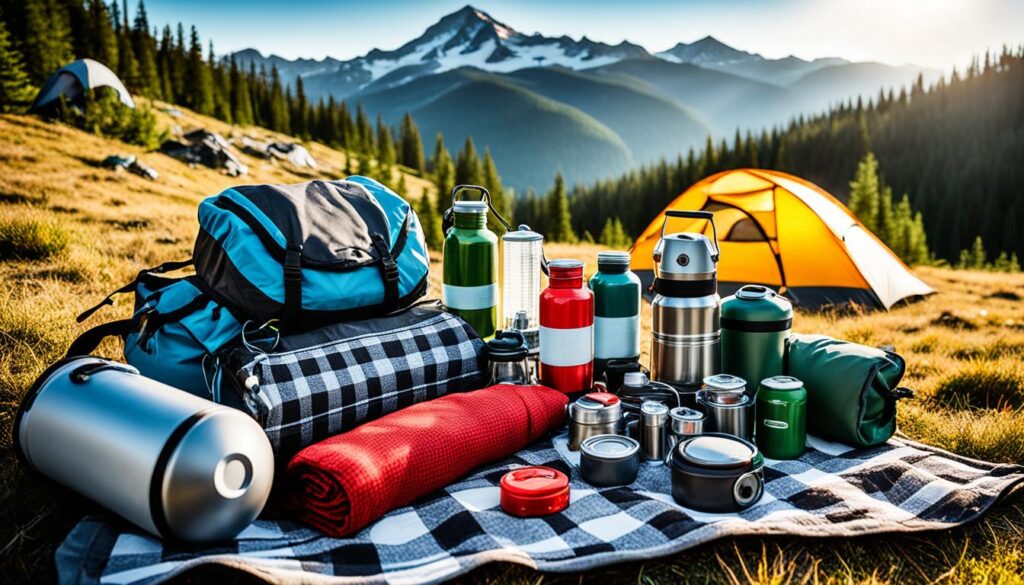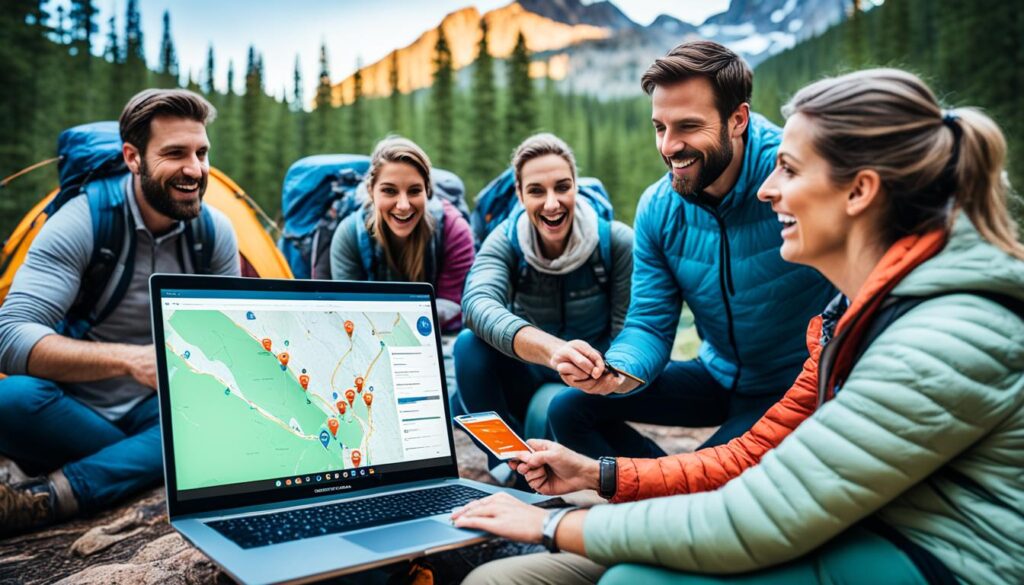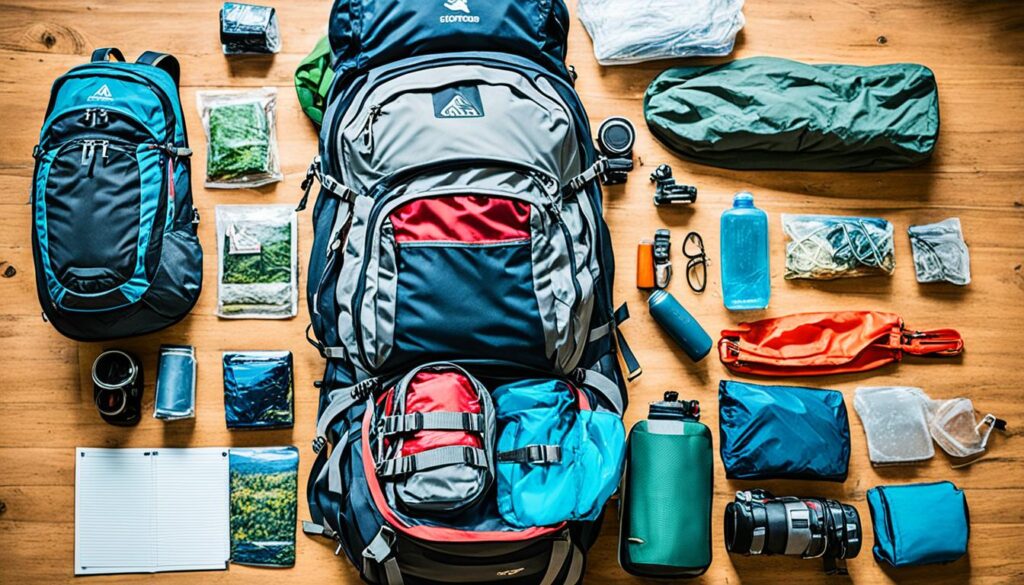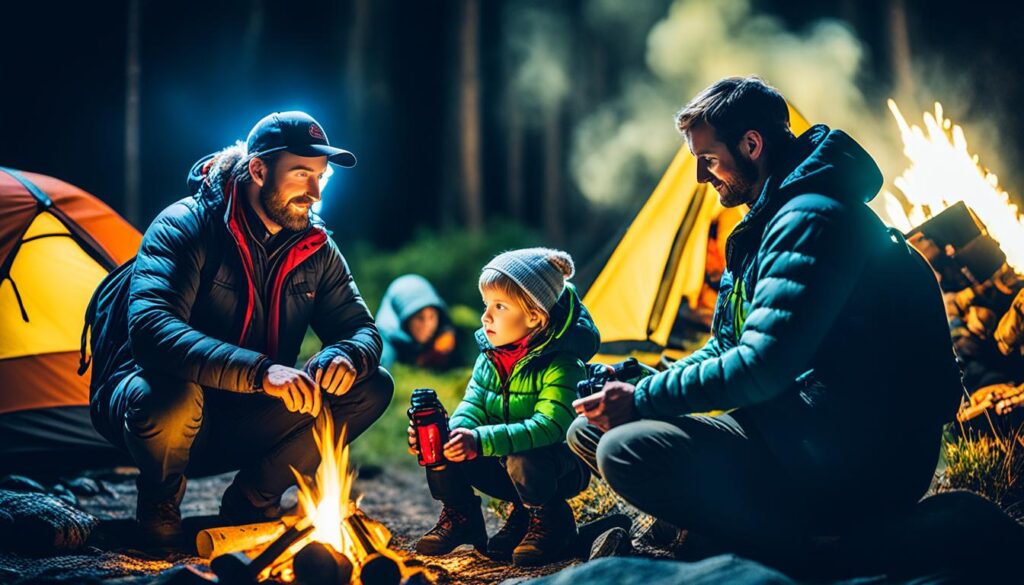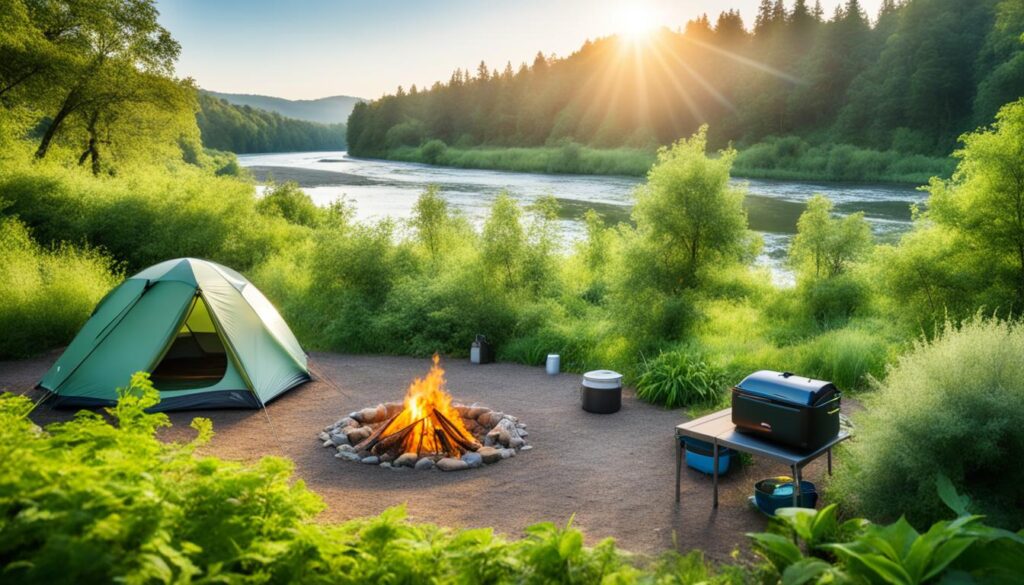Are you ready to embark on a thrilling adventure amid Canada’s magnificent national parks? From awe-inspiring landscapes to exhilarating trails, hiking and camping in Canada offer unparalleled experiences for outdoor enthusiasts like you. But before you set off on your journey, there are essential permits to secure and valuable tips to know.
In this comprehensive guide, we will delve into the world of hiking and camping in Canada’s national parks. Whether it’s exploring the best hiking trails or understanding backcountry camping regulations, we’ve got you covered. So, let’s dive in and discover the wonders that await you in Canada’s wilderness!
Getting Permits for Hiking and Camping
Before embarking on your hiking and camping trip, it’s important to understand the backcountry camping regulations and the camping reservation process. This section will provide all the information you need to secure the necessary permits for an unforgettable experience.
When planning your backcountry camping adventure in Canada’s national parks, it’s crucial to familiarize yourself with the specific regulations in place. These regulations are designed to protect the natural environment and ensure the safety of visitors. Each park may have its own set of rules, so be sure to do your research and understand what is expected of you.
“Responsible camping and adherence to regulations ensure the preservation of pristine wilderness for future generations to enjoy.”
The first step in obtaining permits is to make a camping reservation. This can typically be done online through the official park websites or by calling the park’s visitor center. It’s important to note that campsites fill up quickly, especially during peak seasons, so it’s advisable to make your reservations well in advance.
Backcountry Camping Reservations Process:
- Visit the official website of the national park you intend to visit.
- Navigate to the camping section and choose the backcountry camping option.
- Check the availability of campsites and select your desired dates.
- Provide the required information, including the number of campers and any additional requirements or permits.
- Complete your reservation by making the necessary payment. Some parks may require full payment upfront, while others may only require a deposit.
- Once your reservation is confirmed, you will receive a confirmation email or a permit that you need to print and carry with you during your trip.
By following the backcountry camping regulations and going through the camping reservation process, you can ensure a smooth and organized experience. The next section will explore some of the best hiking trails in Canada, giving you plenty of options to explore during your adventure.
Exploring the Best Hiking Trails in Canada
Canada is renowned for its stunning natural landscapes, and it’s no surprise that the country boasts some of the best hiking trails in the world. Whether you’re a seasoned hiker or a beginner looking for an adventure, Canada offers a plethora of options that cater to all skill levels.
One of the most iconic hiking destinations in Canada is Banff National Park. Located in the heart of the Canadian Rockies, this national park offers a diverse range of hiking trails that showcase the unparalleled beauty of the surrounding mountains, glaciers, and turquoise lakes. From leisurely walks to challenging alpine hikes, there’s something for everyone in Banff.
If you’re seeking a more off-the-beaten-path experience, consider exploring the lesser-known gems of Canada’s hiking trails. For example, the West Coast Trail on Vancouver Island offers a rugged and captivating journey along the Pacific coastline, with stunning views of cliffs, waterfalls, and old-growth forests. Alternatively, head to Newfoundland and Labrador to hike the breathtaking East Coast Trail, where you can encounter ancient fjords, seaside cliffs, and picturesque fishing villages.
“The joy of hiking is not only in reaching the destination but also in the journey itself. Take the time to immerse yourself in the beauty of Canada’s wilderness and let the trails lead you to unforgettable experiences.”
Must-Visit Hiking Trails in Canada
To help you plan your hiking adventure, here are some of the best hiking trails in Canada:
- 1. The West Coast Trail, Vancouver Island, British Columbia
- 2. The Bruce Trail, Ontario
- 3. The Fundy Footpath, New Brunswick
- 4. The Sunshine Coast Trail, British Columbia
- 5. The Berg Lake Trail, British Columbia
- 6. The Skyline Trail, Nova Scotia
- 7. The Rockwall Trail, Kootenay National Park, British Columbia
- 8. The Chilkoot Trail, Yukon
These trails offer an incredible variety of scenery, from coastal landscapes to towering mountains, and each has its own unique charm and challenges.
Remember, when venturing out on Canada’s hiking trails, always be prepared with proper gear, map navigation, and knowledge of the area. Additionally, ensure you follow Leave No Trace principles to help protect the environment and preserve these pristine natural spaces for future generations.
Essential Camping Checklist
When it comes to camping, being well-prepared is essential for a successful outdoor adventure. To ensure you have everything you need, here is a comprehensive checklist of camping essentials:
Camping Gear:
- Tent (with stakes and guylines)
- Sleeping bag
- Sleeping pad or inflatable mattress
- Pillow
- Camp chairs
- Flashlights or headlamps
- Lantern
- Camp stove
- Cooking utensils
- Portable grill
- Cooler
- Firewood and starter
- First aid kit
- Multi-tool or Swiss Army knife
Clothing and Footwear:
- Sturdy hiking boots or shoes
- Hiking socks
- Moisture-wicking base layers
- Insulating layers
- Rain jacket
- Hat or beanie
- Gloves
- Swimsuit
Personal Items:
- Sunscreen
- Insect repellent
- Toilet paper
- Towel
- Toiletries
- Medications
- Personal hygiene products
Food and Drink:
- Non-perishable food items
- Snacks
- Bottled water
- Cooking oil or spray
- Condiments and seasonings
- Coffee or tea
Other Essentials:
- Maps and compass
- Camera
- Binoculars
- Portable phone charger
- Extra batteries
- Campsite reservation confirmation
Remember to customize this checklist based on your specific camping destination, the duration of your trip, and individual needs.
With this comprehensive camping checklist, you can ensure that you have all the necessary gear and supplies for a comfortable and enjoyable outdoor experience. Happy camping!
Understanding Backcountry Camping Regulations
When planning a backcountry camping trip in Canada’s national parks, it’s important to be aware of the specific regulations and guidelines in place. These regulations are designed to protect the natural environment and ensure the safety of both campers and wildlife. By understanding and respecting these rules, you can have a safe and responsible camping experience.
Check Permit Requirements
Before setting off on your backcountry adventure, it’s crucial to check the permit requirements for your chosen park. Each national park has its own regulations regarding backcountry camping permits. Some parks may require you to obtain a permit in advance, while others may have self-registration systems at trailheads. Make sure to familiarize yourself with the specific regulations and obtain the necessary permits.
Follow Leave No Trace Principles
When camping in the backcountry, it’s essential to practice Leave No Trace principles. These principles emphasize minimizing your impact on the natural environment by packing out all trash, disposing of waste properly, and avoiding damage to vegetation. By following these guidelines, you can help preserve the wilderness for future generations to enjoy.
Leave nothing but footprints, take nothing but pictures, kill nothing but time.
Respect Wildlife and Their Habitat
One of the highlights of backcountry camping is the opportunity to observe wildlife in their natural habitat. It’s important, however, to respect their space and not disturb their natural behavior. Keep a safe distance at all times and never feed or approach wild animals. By observing wildlife from a distance and minimizing your impact, you can enjoy their presence while ensuring their safety.
Follow Fire Regulations
Fire regulations are in place to prevent wildfires and protect the natural environment. Before starting a campfire, always check if campfires are allowed in the specific area you are camping in. If campfires are permitted, use designated fire rings or pits and make sure to fully extinguish the fire before leaving the area. Be aware of any fire bans or restrictions that may be in place due to dry conditions or other factors.
Proper Waste Disposal
Proper waste disposal is essential in the backcountry to maintain cleanliness and prevent harm to wildlife. Pack out all trash and dispose of it in designated trash bins or recycling facilities. Human waste should be disposed of using the Leave No Trace principle of burying it in a cathole at least 200 feet away from water sources and campsites. Always follow the park’s guidelines and use designated bathroom facilities when available.
Stay on Designated Trails
Staying on designated trails helps protect fragile ecosystems and prevents unnecessary damage to the environment. Straying from established trails can lead to soil erosion, disturbance of vegetation, and habitat destruction. Follow park signage and maps, and resist the temptation to explore off-trail areas. By sticking to the designated trails, you can minimize your impact on the environment while ensuring your own safety.
By understanding and adhering to backcountry camping regulations, you not only contribute to the conservation of Canada’s national parks but also enhance the overall enjoyment of your camping experience. Remember, these rules are in place to protect the wilderness and ensure everyone’s safety. With proper preparation and responsible camping practices, you can have an unforgettable and sustainable adventure in the backcountry.
Making Camping Reservations
Securing a camping reservation is essential if you want to guarantee your spot in Canada’s beautiful national parks, especially during peak seasons. Fortunately, the camping reservation process is straightforward and can be done online. Follow these tips to ensure a hassle-free experience:
1. Plan Ahead
To increase your chances of securing a camping reservation, it’s crucial to plan ahead and book well in advance. Popular national parks like Banff and Jasper can fill up quickly, so consider making your reservation as soon as the booking window opens. This will help you secure your preferred dates and campsite.
2. Know the Reservation Period
Each national park has its own reservation period, which is typically open several months in advance. Research the specific reservation period for the park you wish to visit to ensure you don’t miss out on the opportunity to book your camping site.
3. Use the Official Website
When making a camping reservation, always use the official website of the national park. This ensures that your reservation is legitimate and gives you access to accurate information and updates.
4. Have Alternative Dates and Campsites
Flexibility is key when it comes to camping reservations. Have alternative dates and campsite options in mind in case your preferred choices are fully booked. This will increase your chances of securing a reservation.
5. Be Mindful of Cancellation Policies
Before finalizing your reservation, familiarize yourself with the cancellation policies. Life happens, and you may need to make changes to your plans. Knowing the policies ahead of time will help you avoid any potential fees or penalties for cancelling or modifying your reservation.
6. Check for Last-Minute Availability
If you haven’t been able to secure a reservation in advance, don’t lose hope. Keep an eye on the campground’s website for any last-minute cancellations or availability. Sometimes, spots open up due to unforeseen circumstances, and you might get lucky.
“Securing a camping reservation is essential if you want to guarantee your spot in Canada’s beautiful national parks, especially during peak seasons.”
To summarize, it’s crucial to plan ahead, use the official website, and be flexible when making camping reservations in Canada’s national parks. By following these tips, you’ll increase your chances of securing the perfect camping spot for an unforgettable outdoor adventure.
| Advantages of Making Camping Reservations | Disadvantages of Not Making Reservations |
|---|---|
| 1. Ensures your preferred dates and campsite | 1. Limited availability, especially during peak seasons |
| 2. Avoids disappointment and last-minute scrambling | 2. Increased risk of not finding an available spot |
| 3. Peace of mind knowing your camping arrangements are secure | 3. Lack of certainty and potential stress in finding alternate camping options |
Preparing for Your Camping Trip
Proper preparation is key to a successful camping adventure. To ensure a smooth and enjoyable experience, follow these essential tips:
Meal Planning and Packing Food
Planning your meals ahead of time will not only save you the stress of figuring out what to eat but also ensure you have enough food for your camping trip. Consider the duration of your trip and the resources available to you. Pack non-perishable food items that are easy to cook and provide sufficient nutrition.
Here’s a sample meal plan and food packing checklist:
| Meal | Food Items |
|---|---|
| Breakfast | Oatmeal, dried fruits, nuts, instant coffee |
| Lunch | Peanut butter and jelly sandwiches, granola bars, fresh fruits |
| Dinner | Pasta, canned vegetables, canned tuna, spices |
| Snacks | Trail mix, beef jerky, energy bars |
| Beverages | Water, tea, powdered drink mixes |
Essential Safety Precautions
Prioritizing safety during your camping trip is crucial. Here are some essential safety precautions to keep in mind:
- Research the area’s wildlife and familiarize yourself with any potential dangers.
- Check the weather forecast before leaving and pack appropriate clothing and gear.
- Inform someone about your camping plans, including your expected return date.
- Carry a first aid kit and know how to use it.
- Follow fire safety guidelines and properly extinguish campfires before leaving.
Gear Maintenance
Proper gear maintenance will not only extend the lifespan of your camping equipment but also ensure their optimal performance. Before heading out on your trip, make sure to:
- Clean and dry camping gear, such as tents, sleeping bags, and cooking utensils.
- Check for any damages or faults in your gear and make necessary repairs or replacements.
- Test camping equipment, such as camping stoves and lanterns, to ensure they are in proper working condition.
Remember, a well-prepared camper is a happy camper!
Follow these tips and prepare for a fantastic camping trip. With careful meal planning, essential safety precautions, and proper gear maintenance, you’ll be ready to embrace the outdoors and create unforgettable memories.
Camping Safety Tips
When embarking on a camping adventure, it’s crucial to prioritize safety. The wilderness can be unpredictable, but by following these expert camping safety tips, you can minimize risks and ensure a safe and enjoyable experience.
1. Be Aware of Wildlife
Encountering wildlife is an exhilarating part of camping, but it’s important to keep a safe distance and respect their habitat. Here are a few essential tips:
- Store all food securely in bear-resistant containers to prevent attracting wildlife.
- Never approach or feed wild animals, as it can disrupt their natural behavior and pose a risk to both you and the animal.
- Learn about the specific wildlife in the area you’ll be camping and understand their behavior to better anticipate encounters.
- If you encounter a bear, remember to remain calm and slowly back away without turning your back on the bear.
2. Practice Fire Safety
While a campfire can create a cozy atmosphere, it’s vital to handle fire with caution to prevent accidents and wildfires. Here are some fire safety tips:
- Check if fire regulations permit campfires in the area where you’ll be camping.
- Always use designated fire pits and ensure they are clear of any flammable material.
- Keep a bucket of water or a fire extinguisher nearby to quickly extinguish the fire if necessary.
- Never leave the fire unattended and completely extinguish it before leaving the campsite or going to sleep.
3. Prepare for Emergencies
Being prepared for emergencies can make all the difference in ensuring your safety while camping. Here are some important steps:
- Pack a well-stocked first-aid kit that includes essential supplies for treating injuries and illnesses.
- Know the location of the nearest medical facilities and emergency services.
- Carry a map, compass, or GPS device, and familiarize yourself with the surrounding area to prevent getting lost.
- Inform someone you trust about your camping plans, including your expected return date and contact them regularly.
“Safety isn’t expensive, it’s priceless. Prioritize safety while camping to make unforgettable memories.”
| Camping Safety Tips | Key Takeaways |
|---|---|
| Be aware of wildlife | Respect wildlife, store food securely, and learn about their behavior to avoid encounters. |
| Practice fire safety | Use designated fire pits, keep control of the fire, and extinguish it properly. |
| Prepare for emergencies | Carry a first-aid kit, know the location of medical facilities, and inform someone of your camping plans. |
By following these camping safety tips, you can enjoy the wonders of nature while ensuring your well-being. Remember, safety is paramount, so always take precautions and be prepared for any situation that may arise.
Unforgettable Camping in Banff National Park
Banff National Park in Canada is a paradise for outdoor enthusiasts, offering breathtaking vistas, pristine wilderness, and a wide range of camping options. Whether you’re an avid hiker or a nature lover looking for a tranquil getaway, Banff has something to offer everyone.
“In every walk with nature, one receives far more than they seek.” – John Muir
One of the highlights of camping in Banff National Park is the opportunity to immerse yourself in the awe-inspiring beauty of the Canadian Rockies. Towering mountains, crystal-clear lakes, and lush forests create a stunning backdrop for your camping adventures.
When it comes to camping options, Banff National Park offers a variety of campgrounds to suit different preferences. Whether you prefer a rustic backcountry experience or the convenience of front-country campgrounds, you’ll find the perfect spot to pitch your tent.
Front-Country Camping
Front-country campgrounds in Banff National Park provide easy access to amenities and are suitable for both RVs and tents. They offer a range of facilities, including picnic tables, fire pits, washrooms, and even hot showers. Some campgrounds also have electrical hook-ups and sewage disposal stations.
Backcountry Camping
If you’re seeking a more secluded and immersive camping experience, backcountry camping in Banff National Park is a great option. Explore remote areas, hike to hidden gems, and sleep under a blanket of stars. However, it’s important to obtain a backcountry camping permit, follow Leave No Trace principles, and be prepared for self-sufficiency.
In addition to camping, Banff National Park boasts an extensive network of hiking trails that showcase the beauty of the region. Whether you’re a seasoned hiker or a beginner, there are trails for every level of experience. From the iconic Moraine Lake to the challenging hike to the summit of Mt. Assiniboine, Banff offers a diverse range of trails that will leave you in awe.
The following table highlights some of the popular hiking trails in Banff National Park:
| Trail Name | Difficulty | Distance | Highlights |
|---|---|---|---|
| Plain of Six Glaciers | Moderate | 13.8 km | Stunning glacier views, teahouse |
| Sulphur Mountain | Easy | 5.5 km | Panoramic views from the summit, Banff Gondola |
| Johnson Canyon | Easy | 4.4 km | Waterfalls, scenic canyon views |
| Consolation Lakes | Easy | 4.4 km | Alpine lakes, mountain scenery |
Must-See Attractions
While camping in Banff National Park, be sure to explore the must-see attractions that make this park truly special. These include:
- The iconic Lake Louise with its turquoise waters and surrounding mountains.
- The stunning Moraine Lake, known for its vibrant blue color and breathtaking views.
- The scenic Icefields Parkway, a renowned driving route that offers majestic mountain vistas and glacier views.
- The Banff townsite, where you can explore shops, restaurants, and immerse yourself in the charming mountain culture.
With its awe-inspiring beauty and a multitude of camping options, Banff National Park is the perfect destination for an unforgettable camping adventure. Whether you choose to stay in front-country campgrounds or venture into the backcountry, you’ll be rewarded with breathtaking views, pristine wilderness, and memories that will last a lifetime.
Tips for an Eco-Friendly Camping Experience
As a nature lover, it’s essential to prioritize eco-friendly practices during your camping trips. By minimizing your impact on the environment, you can enjoy nature responsibly and contribute to its preservation. Here are some eco-friendly camping tips:
1. Leave No Trace
One of the most important principles of eco-friendly camping is to leave no trace. Pack out all your trash, including food waste, and dispose of it properly. Use designated trash bins and recycling facilities, or carry your waste back home if necessary. Leave the campsite the way you found it, so others can enjoy the beauty of nature.
2. Use Sustainable Camping Gear
When choosing your camping gear, opt for sustainable and eco-friendly options. Look for gear made from recycled or sustainable materials. Use biodegradable soaps and toiletries to minimize the impact on the environment. Invest in high-quality gear that lasts longer and reduces waste.
3. Conserve Water
Water is a valuable resource, especially in outdoor environments. Practice water conservation techniques such as taking shorter showers, turning off the faucet while brushing your teeth, and using biodegradable cleaning products. Avoid littering or contaminating water sources to keep them clean for wildlife and future campers.
4. Cook Responsibly
When cooking at the campsite, choose eco-friendly cooking methods. Use a camp stove instead of open fires to minimize the impact on the ecosystem and reduce the risk of wildfires. Also, try using reusable containers and utensils instead of disposable ones to reduce waste.
5. Respect Wildlife
Observe wildlife from a safe distance and avoid interfering with their natural behavior. Do not feed or approach wild animals, as this can disrupt their ecosystem and cause harm to both you and the animals. Store your food securely to prevent attracting wildlife to your campsite.
6. Explore Sustainable Transportation
Consider eco-friendly transportation options when traveling to your camping destination. Carpool with fellow campers or use public transportation if available. If possible, choose campsites that are easily accessible by foot or bike, reducing the carbon footprint of your journey.
“The earth is what we all have in common.”
– Wendell Berry
7. Educate Yourself and Others
Stay informed about environmental issues and educate yourself on ways to protect and conserve nature. Share your knowledge and encourage fellow campers to adopt eco-friendly practices. By inspiring others, you can make a collective impact on preserving the beauty of our natural surroundings.
Remember, every small action makes a difference. By following these eco-friendly camping tips, you can enjoy the beauty of nature while taking care of the environment for future generations.
| Non-Eco-Friendly Practices | Eco-Friendly Alternatives | |
|---|---|---|
| 1. | Using single-use plastic water bottles | Using reusable water bottles or filtration systems |
| 2. | Leaving litter and trash at the campsite | Packing out all trash and properly disposing of it |
| 3. | Using disposable plates and utensils | Using reusable or biodegradable camping utensils |
| 4. | Burning plastic or other non-biodegradable waste | Properly recycling or disposing of waste |
| 5. | Disturbing or feeding wildlife | Observing wildlife from a safe distance and not feeding them |
Staying Safe in Bear Country
In certain national parks, such as Banff National Park, encounters with bears are a possibility. It’s important to be prepared and knowledgeable about bear safety to ensure a safe and enjoyable camping experience.
Proper Food Storage
One of the most important camping safety tips in bear country is to store your food properly to avoid attracting bears to your campsite. Bears have a strong sense of smell and can be attracted to the scent of food from a long distance. To prevent bear encounters:
- Use bear-resistant containers: Store all food, toiletries, and anything with a strong odor in bear-resistant containers. These containers are designed to keep bears out and are an essential item to have when camping in bear country.
- Hang food from a tree: If bear-resistant containers are not available, hang your food at least 10 feet off the ground and 4 feet away from any tree trunk. Use a sturdy rope and secure it properly to prevent bears from reaching it.
- Cook away from your sleeping area: Prepare and cook your meals at least 100 yards away from your sleeping area. This minimizes the smell of food near your campsite, reducing the risk of bears coming near.
Understanding Bear Behavior
It’s crucial to understand bear behavior and know how to react in the presence of bears. Here are some important points to keep in mind:
- Maintain a safe distance: If you encounter a bear while hiking or at your campsite, give it plenty of space. Do not approach the bear or get between a mother bear and her cubs.
- Make noise: While hiking, especially in areas with limited visibility, make noise to alert bears of your presence. This helps prevent surprise encounters that could lead to potential conflicts.
- Never feed or approach bears: Bears that become accustomed to human food can become aggressive and pose a risk to both campers and themselves. Do not leave food out or attempt to approach bears for any reason.
“To prevent bear encounters, store your food properly, maintain a safe distance, and make noise to alert bears of your presence.”
Being informed about bear safety and following these camping safety tips will greatly reduce the risk of conflicts with bears. Remember, bears are wild animals and their behavior can be unpredictable. It’s important to always prioritize safety and be prepared for any situation that may arise.
For more detailed information on bear safety in Banff National Park, refer to the park’s official website and consult with park rangers for the most up-to-date recommendations.
Bear Safety Tips:
| Safety Tip | Description |
|---|---|
| Store food properly | Use bear-resistant containers or hang food from a tree away from your campsite. |
| Maintain a safe distance | Give bears plenty of space and do not approach them or get between a mother bear and her cubs. |
| Make noise | While hiking, make noise to alert bears of your presence and avoid surprising them. |
| Never feed or approach bears | Feeding or approaching bears can make them aggressive and pose a risk to both humans and bears. |
Always prioritize safety and follow the guidelines provided by park authorities to ensure a safe and enjoyable camping experience.
Conclusion
In conclusion, embarking on a hiking and camping adventure in Canada’s national parks is a truly remarkable experience. Whether you are seeking awe-inspiring landscapes, thrilling trails, or peaceful moments in nature, the country offers it all.
To ensure a smooth and enjoyable camping trip, it is important to begin by obtaining the necessary permits. Familiarize yourself with the backcountry camping regulations and follow the proper process for reservation. This way, you can secure your spot and have peace of mind.
Remember to prepare for your trip by using the camping essentials checklist. Packing the right gear and supplies will make your camping experience comfortable and fulfilling. Prioritize safety by following the camping safety tips and being aware of the guidelines for camping in bear country.
If you’re searching for the best hiking trails in Canada, look no further than the iconic Banff National Park. Explore its magnificent beauty and discover other hidden gems across the country. By prioritizing safety, respecting the environment, and following the guidelines, you can create unforgettable memories while experiencing the magic of Canada’s national parks.




























